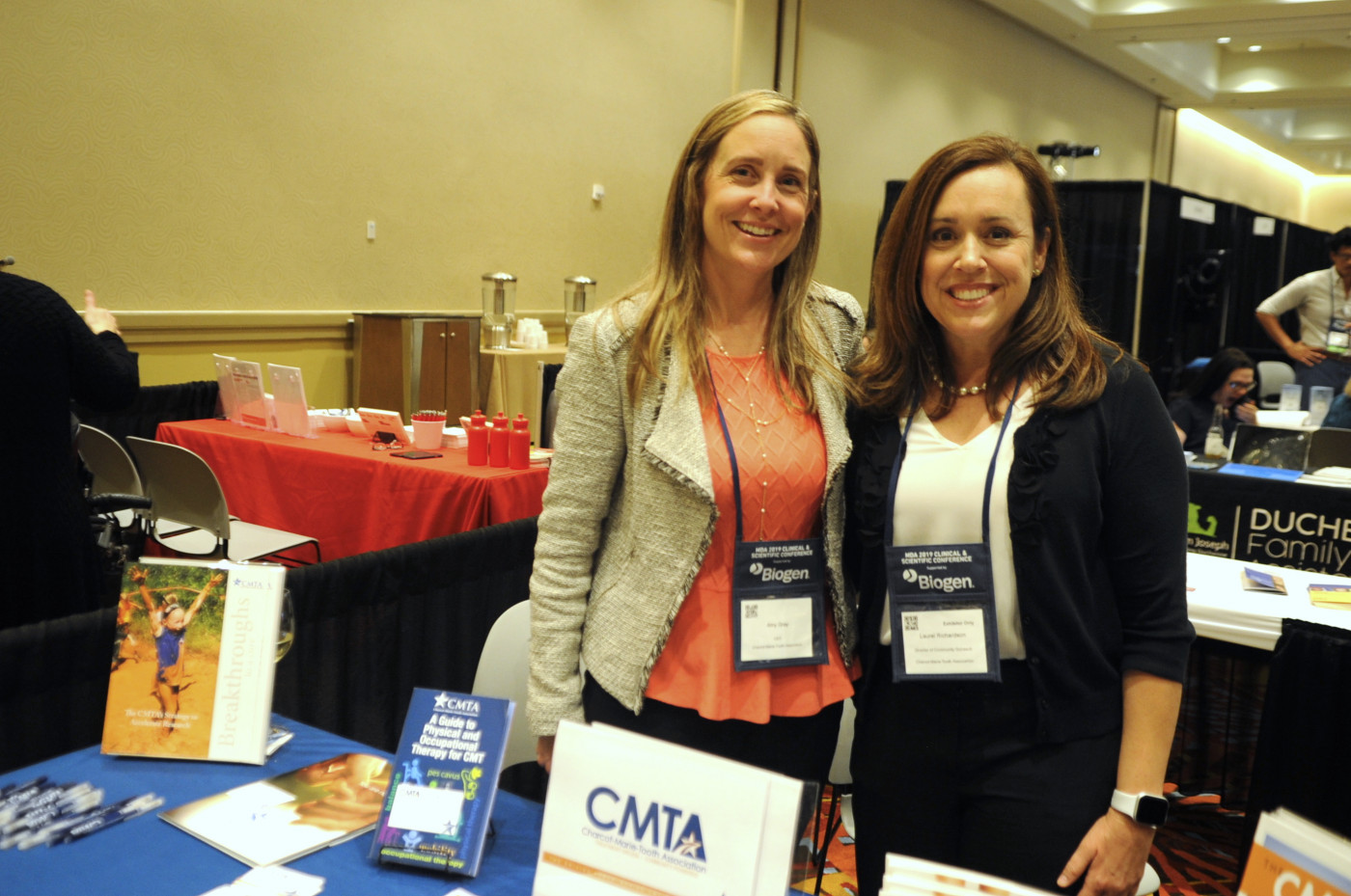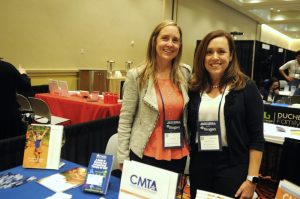CMT Association Shares Latest Disease Therapies, Research at Conference
Written by |

Amy Gray and Laurel Richardson of the CMT Association, at the 2019 MDA Conference in Orlando. (Photo by Larry Luxner)
The Charcot-Marie-Tooth Association (CMTA) has granted $1 million to scientists searching for treatments, but it could cost up to $500 million to bring a viable disease therapy to market, according to the organization’s CEO, Amy Gray.
Speaking April 27 to more than 100 people at CMTA’s Patient & Family Conference in Detroit, Gray was one of several experts who discussed aspects of Charcot-Marie-Tooth disease (CMT), ranging from physical therapy and genetic testing to pain management and research.
The slowly progressing nerve disorder affects an estimated 2.8 million to 3 million individuals worldwide, and between 125,000 and 150,000 in the United States alone, the organization said.
There are no approved therapies addressing the underlying causes of CMT, let alone a cure. Still, Gray called the recent pace of research acceleration “unprecedented,” particularly in the disease’s most common form, CMT1A. She specifically cited momentum in areas of muscle and nerve regeneration.
Much of that progress is driven by the nonprofit’s 11-year-old Strategy to Accelerate Research (STAR) program, which brings together researchers, pharmaceutical companies and patients to find treatments. Through STAR, the Philadelphia-based CMTA has partnerships with at least 20 companies, and more than 50 active research projects globally. It also runs 33 CMT Centers of Excellence, which are multidisciplinary CMT clinics staffed by top experts.
The $1 million in grants, announced April 11, will be split among researchers in Cyprus, Italy and the United States.
CMTA, established in 1983, employs six full-time staffers and many volunteers. In recent years, the charity has poured some $10 million into drug development, and soon will invest $10 million more. One of the organization’s priorities is identifying genes that cause CMT, on top of the 100 or so already linked to the disease, Gray said.
Once scientists find treatments, biomarkers must be available to assess those treatments, she said. Such outcome measures are needed to accurately reflect short-term disease progression. Because CMT usually develops slowly, it can be hard for researchers to discern drug effects in volunteers within the short duration of most trials.
While advances in gene therapy are exciting, they also can be expensive. “So, we have to be smart about it,” Gray said.
For a definitive disease diagnosis, or to learn whether family members are at risk, individuals may consider genetic testing, said Karen Krajewski, a genetics counselor at Detroit’s Wayne State University (WSU). Other reasons to get tested include family planning and possible access to clinical trials.
Stay healthy, expert advises
Krajewski cautioned, however, that some family members may not want or need to be tested, and that test results — even inconclusive ones — may be upsetting. And, because no approved CMT treatments exist, she said, it’s unfair to test asymptomatic children.
“It sort of removes the child’s autonomy,” she said, adding that someone can have CMT with no known family history of the disease. Sometimes, a relative may have only mild symptoms, or attribute symptoms to other conditions.
“But they could just be the first person to be affected in their family,” she said. Although CMT is genetic, it also can develop as a new, spontaneous mutation. The disease can vary greatly, even within the same family.
Jun Li, MD, PhD, chair of the neurology department at WSU’s School of Medicine, noted the “huge expansion” of CMT subtypes in recent years.
Li said he encourages patients to talk with family members about their medical history, and to consider showing family photos to physicians who can look for hand and foot deformities. Still, he cautioned that — even with a family history — symptoms such as decreased sensation in patients’ legs and feet sometimes can be caused by other diseases, including diabetes.
“Patients should do everything they can to stay healthy and not develop these other issues that complicate things,” he said.
Li said CMT patients often feel pain because they overwork a group of muscles to compensate for deformity. Joint pain in CMT1A also is common. He said surgery to correct deformities, in lieu of physical therapy or braces, is a personal decision.
“In some situations it’s not a good idea,” he said. “They could have trouble recovering.”
Maher Fakhouri, MD, a WSU professor of neurology, explained that CMT pain can be both musculoskeletal and neurogenic, meaning it’s caused by or arises in the nervous system. Neuropathic pain symptoms include sensations of tingling, a pulling or tightening, and a feeling of wearing socks all the time.
Although more study is needed, respiratory and sleep disorders also are common CMT complications, said Safwan Badr, MD, division chief of pulmonary critical care at WSU. Those include diaphragmatic impairment, sleep apnea and vocal cord paralysis. Among possible remedies: getting continuous positive airway pressure (CPAP) therapy, losing weight, quitting smoking, sleeping on the side, using jaw advancement devices and getting pharyngeal surgery .
Exercise is crucial
Because CMT can generally affect patients’ feet and ability to stand and walk, orthotics are a common solution.
“They pick up your feet so you’re not tripping over them, they prevent you from rolling your ankles outward or too far, they keep your knees from buckling or popping backward,” said John Galonek, certified prosthetist orthotist for Wright & Filippis and the Rehabilitation Institute of Michigan.
He said patients should monitor their strength and needs to determine what’s best for them. He also said that leg braces can wear out over time, and that newer versions are always available.
Physical therapy also can be helpful, although patients should make sure therapists treat neurological conditions as well as musculoskeletal ones, said Linda McKinney, senior physical therapist at the Detroit Medical Center. She also said stretching feet and ankles are key to keeping muscles balanced, preventing toes from painful clawing, avoiding injury, and staving off the need for orthotics.
McKinney said patients also should work to strengthen their core and hips — even if it’s their ankles and feet that are causing problems — for enhanced stability, safety and independence. She added that fatigue is a common problem in CMT.
“If your baseline endurance is low, this will make walking longer distances more difficult, especially since there are already muscle imbalances that are causing problems too,” she said.
Nora Fritz, an assistant professor with WSU’s physical therapy program, said that while therapists generally don’t know that much about the disease, patients with CMT1 and CMT2 who exercise regularly have been shown to have better elbow function and hand grip than those who don’t. She suggested a home exercise program designed to increase strength and endurance, and improve ankle contractures.
“Without curative treatment, rehabilitation is the best hope for recovery of function,” Fritz said.
Gray, who joined CMTA in 2017, says finding a cure requires money — and lots of it.
“There are mobility issues and a ton of emotional and psychological issues that complicate the physical burdens of the disease. It’s really important for people to understand that,” she said. “The one thing that will speed up research is more funding. I would never put a limit on that — until we have a treatment for every person living with the disease.”
Because the CMTA doesn’t have the capital needed to bring a drug to market, one of its core STAR principles is partnership encouragement. That largely means working with pharmaceutical companies, which do have the necessary resources, the association says on its website.
“In the end, they will carry the ball over the line for us,” it states.





